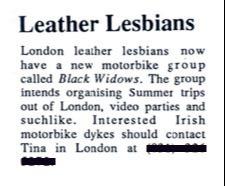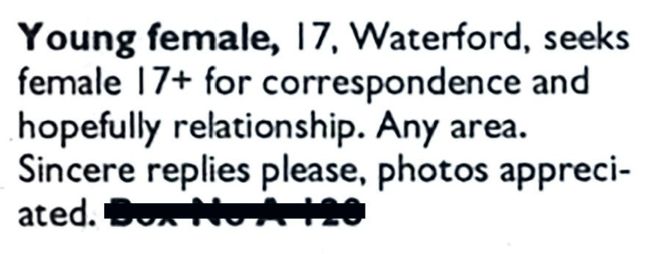Classifieds — Archive — GCN
paper trail
Before there was Tinder, Bumble, Grindr, or Hinge, before a simple swipe could connect two people in an instant, there were personal ads, also known as classifieds. Sarah Creighton Keogh looks at how these small, hopeful messages printed in the back pages of newspapers and magazines, sandwiched between horoscopes and event listings, allowed many queer people to reach out in search of love, companionship, or just someone who understood.
ff or Ireland’s LGBTQ+ community, one of the only spaces for this kind of connection was the personal section of Gay Community News. Launched in 1988 as Ireland’s free national LGBTQ+ publication, GCN provided news, activism, and a crucial sense of belonging at a time when being openly queer was still a radical act. The magazine’s personal ads were more than just dating opportunities— they were lifelines, offering isolated individuals a way to find their people.
In an era when queer people had to navigate deeply ingrained homophobia and the fear of exposure, placing a personal ad in GCN was a bold step. It was a way to reach beyond one’s immediate surroundings, especially in rural Ireland, where LGBTQ+ spaces were few and far between.
The ads themselves were as diverse as the people who wrote them. Some were playful, others poetic; some were direct and to the point, others shrouded in coded language that only those in the know would understand. They offered glimpses into the lives of the people behind them, their desires, their interests, and sometimes, their loneliness.
The GCN debut issue on February 10, 1988, featured an advertisement titled ‘Leather Lesbians’, setting the tone for a magazine that would champion unapologetic queer visibility. The ad read as follows: “London leather lesbians now have a new motorbike group called Black Widows. The group intends organising Summer trips out of London, video parties and suchlike. Interested Irish motorbike dykes should contact Tina in London at...”
From what I could find out about the Black Widows, they were successful in more ways than one, with members riding around the city performing in punk bands like Mouth Almighty and Sluts from Outer Space, to name a few. They also went on to open Chain Reaction, a legendary lesbian S&M club in Vauxhall where leather dykes put on erotic performances with and for each other. And through all of that, they formed a close-knit, inclusive chosen family of loud, proud, sex-positive lesbians with a particular affinity to leather. The Black Widows embodied a radical, uncompromising vision of lesbian identity, intertwining music, fetish culture, and a deep sense of community. Their influence reached far beyond the leather scene, leaving a legacy of queer rebellion that resonated through London’s nightlife and countercultural spaces.



In September 1990, GCN published a stark and simple advertisement: ‘Lonely lesbian’. It read, “Lonely lesbian seeks similar for friendship and hopefully something longer-lasting. Likes gory films and takeaways, preferably Chinese.” In just a few words, it captured the isolation that many queer individuals faced, particularly before mainstream society began to acknowledge LGBTQ+ lives with any real sincerity.
Unlike more playful or provocative ads, this one offered a quiet yet deeply emotional glimpse into the struggles of lesbian existence at a time when visibility was still a battle. It was a reminder that beyond the activism and defiance, there were also moments of longing, solitude, and the search for connection.
One of the many people who turned to GCN’s personal ads for connection was Dawn. It was 1994, and she had just come out to her friends in Tramore, a small town where being openly gay was still a local scandal. Without any queer community around her, she decided to take a leap of faith—placing an ad in GCN.
She wasn’t sure what to expect. At the time, simply putting her name out there as a lesbian felt like an act of bravery. But she was hopeful. Even if she didn’t meet someone romantically, maybe she’d find a pen pal, another lesbian who understood what she was going through.
“Young female, 17, Waterford, seeks female 17+ for correspondence and hopefully relationship. Any area. Sincere replies please, photos appreciated,” she wrote.
One of the people who responded to Dawn’s ad was Paula. When she saw Dawn’s ad, something about it stood out to her—maybe it was instinct, maybe it was the fact that Dawn was nearby, making it easier to meet without having to travel to Dublin.
She decided to write back. Dawn remembers the thrill of receiving Paula’s first letter. In those pre-internet days, waiting for the post was a mix of nervous anticipation and excitement. The sight of Paula’s handwriting on an envelope would brighten her entire day.
Along with her letter, Paula sent a photo of herself with her little brother. Dawn was immediately drawn to what she describes as her pretty eyes and lovely smile. Their correspondence quickly became a regular rhythm— writing to each other about their daily lives, work, nights out with friends.
By September 1994, just a few months after their first exchange, they decided to meet in person. Their first date was the day after Dawn’s Debs. Both were nervous but excited. The first meeting was a little awkward, as first meetings often are, but there was no denying that sparks were already flying.
Dawn and Paula’s love story is a far cry from how most relationships begin today. In the age of online dating, where conversations start and end in a matter of minutes, the slow and deliberate process of writing letters, waiting for replies, and building a connection over time feels almost romanticised.
Both Dawn and Paula acknowledge the benefits of modern technology—dating apps have made it easier to find other LGBTQ+ people, especially in isolated areas. But they also feel that something has been lost in the process. “We got to know each other through letters and phone calls. We took the time to learn about each other’s interests before meeting in person.”
That patience and intention, they believe, created a deeper foundation. Dawn, ever the romantic, still has most of the letters and cards Paula sent her—physical reminders of the early days of their relationship. Unlike emails or text messages, which can be deleted with a tap, letters hold history. They capture a moment in time.
Fast forward 31 years, and Dawn and Paula are still together. They’ve been through life’s ups and downs, but they’ve always had each other. They now live in a small village in Tipperary, where they are affectionately known by locals as ‘the Girls’.
At 48 and 52, they spend their days enjoying gardening, reading, watching their favourite shows, and cheering on Manchester United. Looking back, Dawn sometimes wonders how different life might have been if she had never placed that ad. But she wouldn’t change a thing. “I wouldn’t trade the last 31 years for the Irish Presidency!” she laughs.
As they reflect on their story, Dawn and Paula hope it inspires others to slow down, to take the time to express their feelings in a way that lasts. “We highly recommend writing letters,” they say. “There’s something special about it. And who knows? Maybe you’ll keep those letters for decades, just like we did.” Their advice to today’s generation of queer daters? Take a chance. Put yourself out there. Whether in a magazine ad or a heartfelt letter to a loved one, words have power. After all, you never know who might be on the other side, waiting for your message.
To explore more personal ads in GCN, visit the digital archive at archive.gcn.ie.